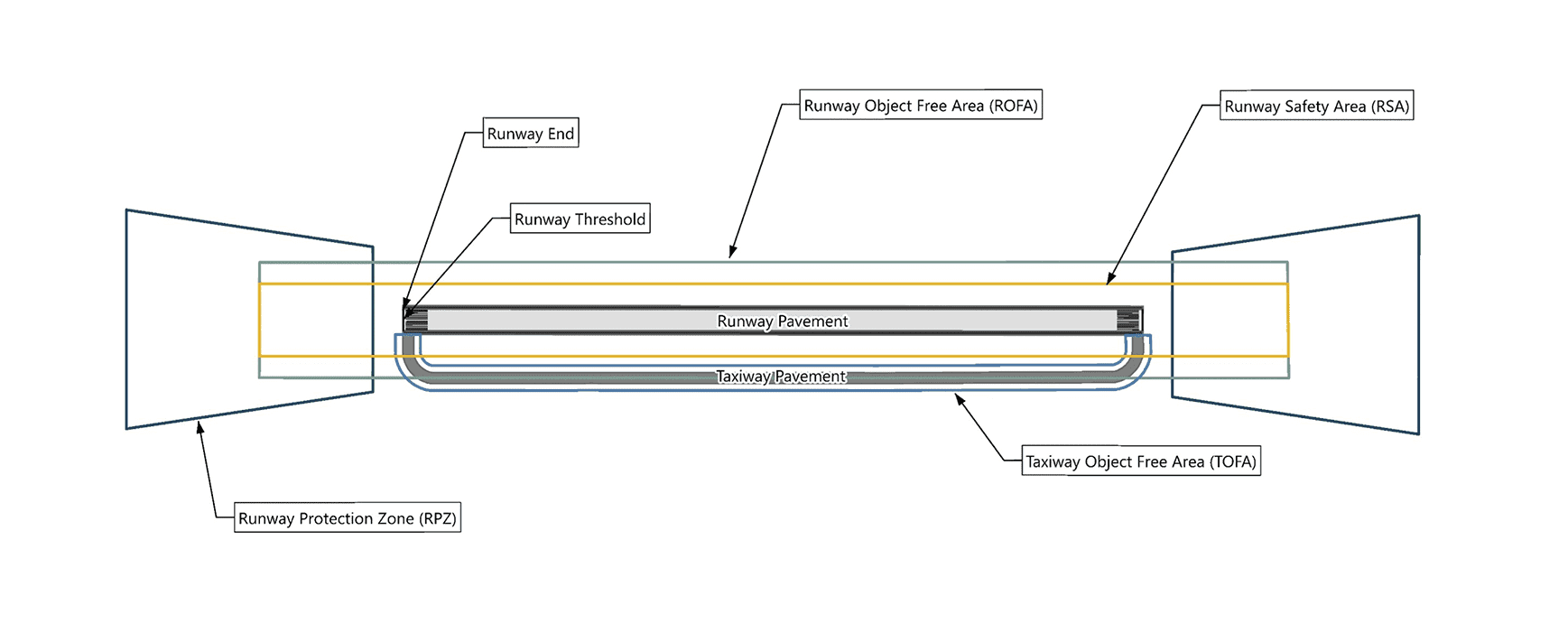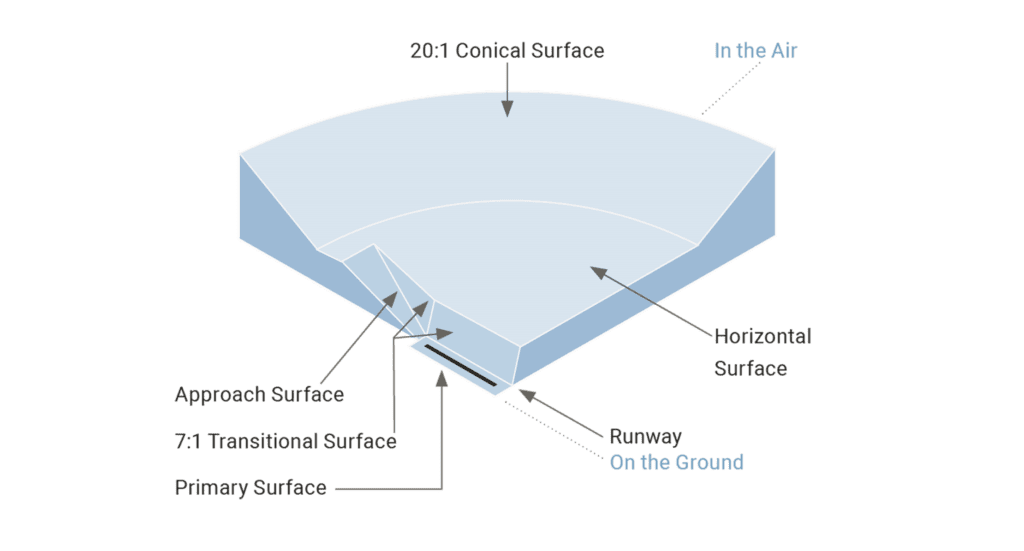The mission of the FAA is to provide the safest, most efficient aerospace system in the world. The role of the FAA Office of Airports division in meeting this goal is to provide leadership in planning and developing a safe and efficient national airport system to satisfy the needs of aviation interests of the United States. The safe operation of each airport and airway system is the highest aviation priority (49 U.S.C. §§ 47101(a)(1) and 40101).
The FAA’s Airport Safety Program addresses general aviation airport safety; runway safety; and safety management systems (SMS) for all commercial service airports certificated under 14 Code of Federal Regulations (CFR) Part 139, Certification and Operations: Land Airports Serving Certain Air Carriers (such as CRW). In 1999, the FAA established the Runway Safety Area (RSA) Program with the objective that all RSAs at federally obligated airports and all RSAs at airports certificated under 14 CFR Part 139 shall conform to FAA design standards to the extent practicable. The FAA’s Runway Safety Area Program continues to evolve based on changes in airport design requirements and FAA metrics evaluating the severity of potential runway incursions in order to address safety risks and plan for future improvements. It remains FAA policy for RSAs at federally obligated airports and at airports certificated under 14 CFR Part 139 to conform to FAA design standards.
The FAA actively maintains several different types of policies, procedures, and guidance documents that govern airport development. The Advisory Circular (AC) system provides a single, uniform, agency-wide system that the FAA uses to deliver advisory and informational material to FAA customers, industry, the aviation community, and the public. ACs cover a broad range of topics within the FAA and can be directional, informational, or descriptive. The ACs that contain current FAA standards and recommendations for airport design are FAA AC 150/5300-13B, Airport Design, and FAA AC 150/5325-4B, Runway Length Requirements for Airport Design. FAA AC 150/5300-13B provides design standards for runways, runway associated elements and taxiways, as well as other airfield facilities. Design standards in these ACs are established for categories of aircraft with similar characteristics and are used to design or update an airport facility. Key planning terms associated with runway design that are applicable to the project are defined below.
- Airplane Design Groups (ADGs) – Classifies aircraft into six groups, indicated by Roman numerals I-VI, based on aircraft wingspan and tail height, which reflect the operating needs of an aircraft.
- Critical Aircraft – The critical aircraft is the most demanding aircraft type, or grouping of aircraft with similar characteristics, that make regular use (500 annual operations) of an airport.
- Declared Distances – Specific lengths of a runway that are published as available for use for aircraft operations, specifically when taking off or landing. Declared distances are defined for pilots to understand their allowable take-off and landing weights and speeds and specifically include:
- Takeoff Run Available (TORA) – The amount of runway available for the ground run of an aircraft taking off.
- Takeoff Distance Available (TODA) – The length of the TORA plus the amount of any remaining runway.
- Accelerate-Stop Distance Available (ASDA) – The amount of runway available for an aircraft to reach liftoff speed then decelerate without over-running the runway in the event takeoff is aborted.
- Landing Distance Available (LDA) – The runway length declared available and suitable for landing an airplane.
- Engineered Material Arresting System (EMAS) – Engineered crushable material placed at the end of a runway to stop or slow an aircraft that overruns the runway.
- Navigational Aid (NAVAID) – Electronic and visual devices on the ground that aids an aircraft by guiding and navigating it to its destination.
- Runway Object Free Area (ROFA) – An area centered on the runway centerline that should be clear of aboveground objects, in order to protect the wings of an aircraft operating on the runway. Certain objects necessary for air navigation and aircraft ground movements are allowable within the ROFA, including runway and taxiway lighting and signage.
- Runway Protection Zone (RPZ) – A trapezoidal area off the end of a runway, centered on the runway centerline, that should be cleared of incompatible uses and activities in order to provide a safe, clear space for aircraft takeoffs and approaches, and to protect people and property on the ground.
- Runway Safety Area (RSA) – The graded surface surrounding a runway (sides and ends) that is prepared or suitable for reducing the risk of damage to aircraft in the event of an undershoot, overshoot, or excursion from the runway. RSA dimensions depend on the type of aircraft operating at the airport.
- Runway Threshold – Markings across the runway that denote the beginning and end of the designated space for landing under non-emergency conditions.
- Taxiway Object Free Area (TOFA) – An area centered on a taxiway centerline that should be clear of aboveground objects, with the exception of those necessary for air navigation and aircraft ground movements in order to protect the wings of an aircraft operating on the taxiway.
- Taxiway Safety Area – The graded surface surrounding the taxiway (sides and ends) that is prepared or suitable for reducing the risk of damage aircraft should they deviate from the taxiway.

The FAA is also responsible for administering navigable airspace under 14 CFR Part 77, Safe, Efficient Use and Preservation of the Navigable Airspace (Part 77). The FAA must act in the public interest as necessary to ensure the safety of aircraft and the efficient use of airspace. Part 77 establishes standards used to determine obstructions to air navigation and navigational and communication facilities; it also specifies the requirements for identifying potential hazardous effects to air navigation from any proposed construction or alteration on or near airports. Part 77 defines the primary, approach, transitional, horizontal, and conical surfaces for a runway, as shown below. For civil airports which includes CRW, imaginary surfaces are established to evaluate and protect the approach and departure areas of a runway and are developed with relation to the specific airport and to each runway. The size of each such imaginary surface is based on the category of each runway according to the type of approach available or planned for that runway (that is, visual, instrument, etc.) and must be kept clear of objects that might damage an aircraft. Penetrations of fixed objects into the Part 77 surfaces are considered obstructions.



